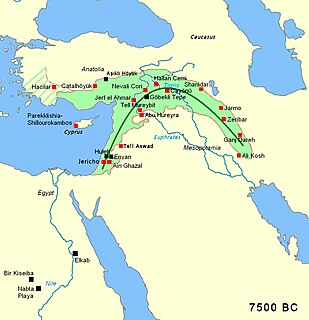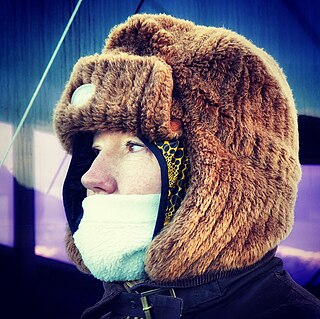Related Research Articles

Andrew Colin Renfrew, Baron Renfrew of Kaimsthorn, is a British archaeologist, paleolinguist and Conservative peer noted for his work on radiocarbon dating, the prehistory of languages, archaeogenetics, neuroarchaeology, and the prevention of looting at archaeological sites.

The Rickettsiaceae are a family of bacteria. The genus Rickettsia is the most prominent genus within the family. The bacteria that eventually formed the mitochondrion is believed to have originated from this family. Most human pathogens in this family are in genus Rickettsia. They spend part of their lifecycle in the bodies of arthropods such as ticks or lice, and are then transmitted to humans or other mammals by the bite of the arthropod. It contains Gram-negative bacteria, very sensitive to environmental exposure, thus is adapted to obligate intracellular infection. Rickettsia rickettsii is considered the prototypical infectious organism in the group.

Probable G-protein coupled receptor 158 is a protein that in humans is encoded by the GPR158 gene.
The various ethnolinguistic groups found in the Caucasus, Central Asia, Europe, the Middle East, North Africa and/or South Asia demonstrate differing rates of particular Y-DNA haplogroups.

The Pre-Pottery Neolithic (PPN) represents the early Neolithic in the Levantine and upper Mesopotamian region of the Fertile Crescent, dating to c. 12,000 – c. 8,500 years ago,. It succeeds the Natufian culture of the Epipalaeolithic Near East, as the domestication of plants and animals was in its formative stages, having possibly been induced by the Younger Dryas.
Paola Sebastiani is a biostatistician and a professor at Boston University working in the field of genetic epidemiology, building prognostic models that can be used for the dissection of complex traits. Her research interests include Bayesian modeling of biomedical data, particularly genetic and genomic data.

Neanderthals are an extinct species or subspecies of archaic humans who lived in Eurasia until about 40,000 years ago. While the "causes of Neanderthal disappearance about 40,000 years ago remain highly contested," demographic factors such as small population size, inbreeding, and random fluctuations are considered probable factors. Other scholars have proposed competitive replacement, assimilation into the modern human genome, great climatic change, disease, or a combination of these factors.

Special AT-rich sequence-binding protein 2 (SATB2) also known as DNA-binding protein SATB2 is a protein that in humans is encoded by the SATB2 gene. SATB2 is a DNA-binding protein that specifically binds nuclear matrix attachment regions and is involved in transcriptional regulation and chromatin remodeling. SATB2 shows a restricted mode of expression and is expressed in certain cell nuclei. The SATB2 protein is mainly expressed in the epithelial cells of the colon and rectum, followed by the nuclei of neurons in the brain.
George Speake, is an English art historian and archaeologist. He is an Honorary Research Fellow at the Institute of Archaeology at Oxford, and "a leading authority on Anglo-Saxon animal art." Currently Speake is the Anglo-Saxon Art and Iconography Specialist for the Staffordshire Hoard conservation team, and is working on the reconstruction of the Staffordshire helmet.

Ruth Nussinov is an Israeli-American biologist who works as a Professor in the Department of Human Genetics, School of Medicine at Tel Aviv University and is the Senior Principal Scientist and Principal Investigator at the National Cancer Institute, National Institutes of Health. Nussinov is also the Editor in Chief for the journal PLOS Computational Biology.
Computational social science is the academic sub-discipline concerned with computational approaches to the social sciences. This means that computers are used to model, simulate, and analyze social phenomena. Fields include computational economics, computational sociology, cliodynamics, culturomics, and the automated analysis of contents, in social and traditional media. It focuses on investigating social and behavioral relationships and interactions through social simulation, modeling, network analysis, and media analysis.

Kate Robb is an Australian marine mammalogist who, along with colleagues, declared in 2011 a new species of the genus Tursiops, and formally named it the Burrunan dolphin, Tursiops australis. She is the Founding Director and Head of Research at the Marine Mammal Foundation in Melbourne in the Australian state of Victoria.

Professor Ramakrishna Vijayacharya Hosur is an Indian biophysical scientist, known for his expertise in the areas of nuclear magnetic resonance and molecular biophysics. The Government of India honoured him, in 2014, by awarding him the Padma Shri, the fourth highest civilian award, for his contributions to the fields of science and technology.
Joseph A. Bulbulia is a Professor of Psychology in the Faculty of Science at Victoria University of Wellington (2020-present). He was the Maclaurin Goodfellow Chair in the School of Humanities, Faculty of Arts at University of Auckland (2018-2020). He previously served as a Professor in the School of Art History, Classics and Religious Studies at Victoria University of Wellington. Bulbulia is regarded as one of the founders of the contemporary evolutionary religious studies. He is a past President of the International Association for the Cognitive Science of Religion and is currently co-editor of Religion, Brain & Behavior. Bulbulia is one of four on the Senior Management Team of the New Zealand Attitudes and Values Study, a 20-year longitudinal study tracking over 15,000 New Zealanders each year. He is an associate investigator for Pulotu, a database of 116 Pacific cultures purpose-built to investigate the evolutionary dynamics of religion. In 2016 Bulbulia won a Research Excellence Award at Victoria University.

Sander L. van der Linden is a social psychologist and professor of social psychology in society in the department of psychology at the University of Cambridge, England where he has directed the Cambridge Social Decision-Making Laboratory since 2016. He is also a fellow and director of studies in psychological and behavioural sciences at Churchill College, Cambridge, a research affiliate of the Yale Program on Climate Change Communication at Yale University and the Winton Centre for Risk and Evidence Communication at the University of Cambridge.

Dominic Kwiatkowski is head of the parasites and microbes programme at the Wellcome Sanger Institute in Cambridge and a Professor of Genomics at the University of Oxford. Kwiatkowski applies genomics and computational analysis to problems in infectious disease, with the aim of finding ways to reduce the burden of disease in the developing world.

Jacqueline Mulville is a British bioarchaeologist and Professor of Archaeology at Cardiff University. Mulville is a field archaeologist whose research focuses on osteoarchaeology, human and animal identities, and island archaeologies concentrated on Britain.
Naomi Sykes FSA is a zooarchaeologist and is currently the Lawrence Professor of Archaeology at the University of Exeter. Sykes researches human-animal relations in the past.
Joanna Rachel Sofaer Derevenski, known as Joanna Sofaer, is a British archaeologist and academic, who specialises in the European Bronze Age, using theoretical approaches, and material culture studies. She is Professor of Archaeology at the University of Southampton.
R. Helen Farr is a British maritime archaeologist and prehistorian who specialises in prehistoric submerged landscapes and early seafaring. Farr is a certified (HSE) commercial diver. She is Lecturer in the Marine and Maritime Institute in the Department of Archaeology at the Southampton University. Farr was elected as a Fellow of the Society of Antiquaries of London on 17 October 2019.
References
- 1 2 "Dr Sonia Zakrzewski". University of Southampton. Retrieved 2 April 2020.
- ↑ "Fellows Directory - Sonia Ruth Zakrzewski". Society of Antiquaries of London. Retrieved 2 April 2020.